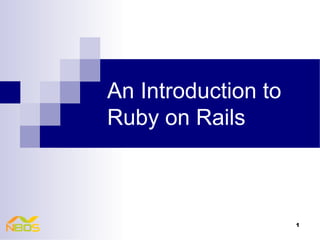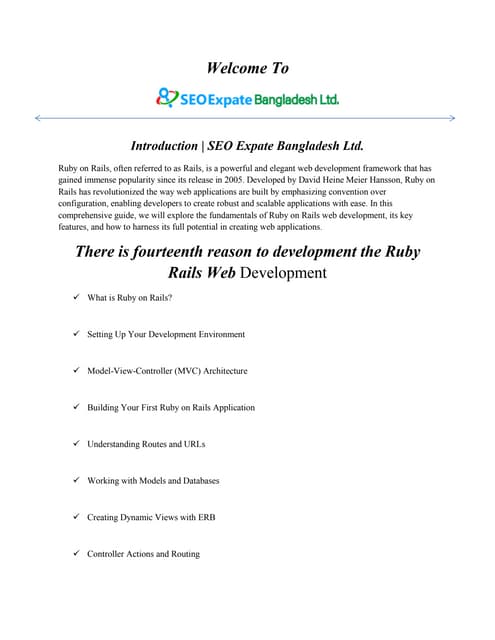Ruby on Rails introduction
- 1. An Introduction to Ruby on Rails 1
- 2. An Introduction to Ruby and Rails Outline ?What is Ruby? ?What is Rails? ?Rails overview. ?Sample RoR application and also with Spree gem. 2
- 3. An Introduction to Ruby and Rails What is Ruby? ? Ruby is a pure object oriented programming language. It was created on February 24, 1993 by Yukihiro Matsumoto of Japan. Ruby is a general-purpose, interpreted programming language. 3
- 4. An Introduction to Ruby and Rails What is Rails? ? Rails is a web application development framework written in the Ruby language. It is designed to make programming web applications easier by making assumptions about what every developer needs to get started. ? Open Source (MIT license) ? Based on a existing application (Basecamp) ? Provides common needs: - Routing, sessions - Database storage - Business logic - Generate HTML/XML/CSS/Ajax ? It allows you to write less code while accomplishing more than many other languages and frameworks. 4
- 5. An Introduction to Ruby and Rails Rails Advantages ? Convention over configuration ? Don¨t Repeat Yourself ? Object Relational Mapping ? Model View Controller ? Reuse of code 5
- 6. An Introduction to Ruby and Rails Convention over Configuration ? Table and foreign key naming - Tables are multiples (users, orders, ´) - Foreign key naming: user_id ? Default locations - MVC, Test, Languages, Plugins ? Naming - Class names: CamelCase - Files: lowercase_underscored.rb 6
- 7. An Introduction to Ruby and Rails Don¨t repeat yourself ? Everything is defined in a single, unambiguous place ? Easier to find code - Only need to look once - Can stop looking when found - Well defined places for most items ? Much easier to maintain code - Faster to change - Less inconsistency bugs 7
- 8. 8An Introduction to Ruby and Rails MVC ? Model - Object relationships (users, orders) ? Controller - Business logic (perform a payment) ? View - Visual representation (generate HTML/XML) 8
- 9. An Introduction to Ruby and Rails Object Relational Mapping - Easily stored and retrieved from a database without writing SQL statements directly - Use with less overall database access code 9
- 10. An Introduction to Ruby and Rails Re-use of code ? Gems and plugins, more then 1300 - For authentication, pagination, testing, ´ ? Git allows easy forking and merging 10
- 11. An Introduction to Ruby and Rails Rails Disadvantages ? Rails is inefficient ? Rails is hard to desploy 11
- 12. An Introduction to Ruby and Rails Rails is inefficient ? Rails uses a lot of memory, up to 150MB per instance ? Requires more application servers ? Where are your development constrains? 12
- 13. An Introduction to Ruby and Rails Rails is hard to deploy ? Harder than PHP, better with Passenger ? Lots of moving parts - Rails, apps, gems, plugins - Application server, webserver ? Deployment via scripts - Via the Capistrano tool - Easy to break something ? Deployment to multiple servers 13
- 14. An Introduction to Ruby and Rails Quick Rails Demo: ? $ rails new RoRApp $ cd RoRApp (Use an Aptana studio IDE) ? We have 3 environments( in config/database.yml) 1.Development 2.Test 3.Production 14
- 15. ? If we want to configure the database as mysql2(default database is sqllite), open the file config/database.yml and modify the database name and options. development: adapter: mysql2 encoding: utf8 database: db/development/dev username: root Password: '123456' ? And also we need to add myspl2 gem in Gemfile as gem 'mysql2' An Introduction to Ruby and Rails Configuring the Database: 15
- 16. An Introduction to Ruby and Rails Now we need to bundle update which installs the mysql2 gem for our application. $ bundle update Create a Database : ? Now we have our database is configured, it¨s time to have Rails create an empty database. We can do this by running a rake command: $ rake db:create 16
- 17. An Introduction to Ruby and Rails 1.rails s (or) (default port is 3000) 2.rails server (or) 3.rails s -p 4000 ? Verify whether the rails app is working properly or not by browsing http://localhost:3000 ? Here the default page is rendering from public/index.html 17
- 18. 18
- 19. An Introduction to Ruby and Rails ? If we want to display a user defined text or anything in our home page, we need to create a controller and a view $ rails generate controller home index Rails will create several files, including app/views/home/index.html.erb and app/controllers/home_controller.rb ? To make this index file as the home page, 1st we need to delete the default public/index.html page $ rm public/index.html 19
- 20. An Introduction to Ruby and Rails ? Now, we have to tell Rails where your actual home page is located. For that open the file config/routes.rb and edit as root :to => "home#index" ? Check whether our home page is rendering proper page or not, for that we need to start the rails serve as $ rails s 20
- 21. An Introduction to Ruby and Rails Scaffolding Rails scaffolding is a quick way to generate some of the major pieces of an application. If you want to create the models, views, and controllers for a new resource in a single operation, scaffolding is the tool for the job. Example: Creating a Resource for sessionApp: We can start by generating a scaffold for the Post resource: this will represent a single blog posting. $ rails generate scaffold Post name:string title:string content:text 21
- 22. An Introduction to Ruby and Rails File Purpose db/migrate/20120606184725_create_po sts.rb Migration to create the posts table in your database (your name will include a different timestamp) app/models/post.rb The Post model config/routes.rb Edited to include routing information for posts app/controllers/posts_controller.rb The Posts controller app/views/posts/index.html.erb A view to display an index of all posts app/views/posts/edit.html.erb A view to edit an existing post app/views/posts/show.html.erb A view to display a single post app/views/posts/new.html.erb A view to create a new post 22
- 23. An Introduction to Ruby and Rails Running a Migration: ? Rails generate scaffold command create is a database migration. Migrations are Ruby classes that are designed to make it simple to create and modify database tables. Rails uses rake commands to run migrations, and it¨s possible to undo a migration ($ rake db:migrate rollback) after it¨s been applied to your database. 23
- 24. An Introduction to Ruby and Rails ? If we look in the db/migrate/20120606184725_create_posts.rb class CreatePosts < ActiveRecord::Migration def change create_table :posts do |t| t.string :name t.string :title t.text :content t.timestamps end end ? At this point, we can use a rake command to run the migration: $ rake db:migrate 24
- 25. An Introduction to Ruby and Rails Rails will execute this migration command and tell you it created the Posts table. == CreatePosts: migrating =================================================== = -- create_table(:posts) -> 0.0019s == CreatePosts: migrated (0.0020s) =========================================== 25
- 26. An Introduction to Ruby and Rails Adding a Link: ? We can add a link to the home page. Open app/views/home/index.html.erb and modify it as follows: <h1>Hello, Rails!</h1> <%= link_to "New Post", posts_path %> When we run the server it displays the home page as 26
- 27. An Introduction to Ruby and Rails The Model: ? The model file, app/models/post.rb is class Post < ActiveRecord::Base attr_accessible :content, :name, :title end ? Active Record supplies a great deal of functionality to our Rails models for free, including basic database CRUD (Create, Read, Update, Destroy) operations, data validation 27
- 28. An Introduction to Ruby and Rails Adding Some Validation: ? Rails includes methods to help you validate the data that you send to models. Open the app/models/post.rb file and edit it: class Post < ActiveRecord::Base attr_accessible :content, :name, :title validates :name, :presence => true validates :title, :presence => true, :length => {:minimum => 5} end 28
- 29. An Introduction to Ruby and Rails Listing All Posts ? How the application is showing us the list of Posts. ? Open the file app/controllers/posts_controller.rb and look at the index action: def index @posts = Post.all respond_to do |format| format.html # index.html.erb format.json { render :json => @posts } end end 29
- 30. An Introduction to Ruby and Rails ? The HTML format(format.html) looks for a view in app/views/posts/ with a name that corresponds to the action name(index). Rails makes all of the instance variables from the action available to the view. Here¨s app/views/posts/index.html.erb: 30
- 31. An Introduction to Ruby and Rails <h1>Listing posts</h1> <table> <tr> <th>Name</th> <th>Title</th> <th>Content</th> <th></th> <th></th> <th></th> </tr> <% @posts.each do |post| %> <tr> <td><%= post.name %></td> <td><%= post.title %></td> <td><%= post.content %></td> <td><%= link_to 'Show', post %></td> <td><%= link_to 'Edit', edit_post_path(post) %></td> <td><%= link_to 'Destroy', post, :confirm => 'Are you sure?', :method => :delete %></td> </tr> <% end %> </table> <br /> <%= link_to 'New post', new_post_path %> 31
- 32. Creating an App using spree: ? Spree is a full featured commerce platform written for the Ruby on Rails framework. It is designed to make programming commerce applications easier by making several assumptions about what most developers needs to get started. Spree is a production ready store. An Introduction to Ruby and Rails 32
- 33. ? Now we are going to see how we create e-commerce(spree) application. $ rails new SpreeApp $ cd SpreeApp $ spree install Would you like to install the default gateways? (yes/no) [yes] yes Would you like to run the migrations? (yes/no) [yes] yes Would you like to load the seed data? (yes/no) [yes] yes Would you like to load the sample data? (yes/no) [yes] yes Admin Email [spree@example.com] Admin Password [spree123] Would you like to precompile assets? (yes/no) [yes] yes $ rails server An Introduction to Ruby and Rails 33
- 34. An Introduction to Ruby and Rails 34
- 35. An Introduction to Ruby and Rails THANK YOU! 35
































![? Now we are going to see how we create
e-commerce(spree) application.
$ rails new SpreeApp
$ cd SpreeApp
$ spree install
Would you like to install the default gateways? (yes/no) [yes] yes
Would you like to run the migrations? (yes/no) [yes] yes
Would you like to load the seed data? (yes/no) [yes] yes
Would you like to load the sample data? (yes/no) [yes] yes
Admin Email [spree@example.com]
Admin Password [spree123]
Would you like to precompile assets? (yes/no) [yes] yes
$ rails server
An Introduction to Ruby and Rails 33](https://image.slidesharecdn.com/ror-120718011520-phpapp02-160703163103/85/Ruby-on-Rails-introduction-33-320.jpg)





































































